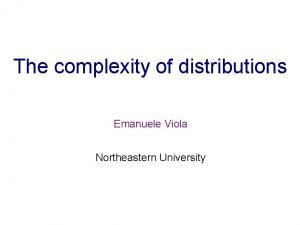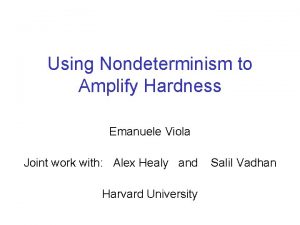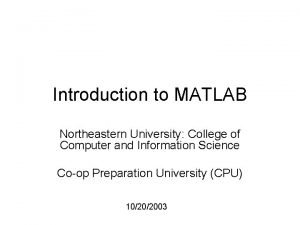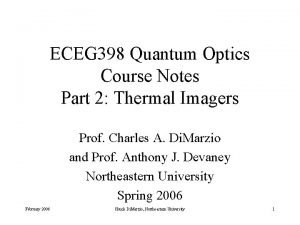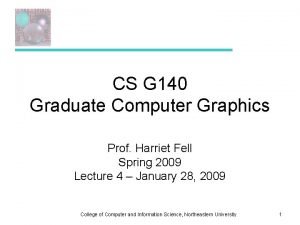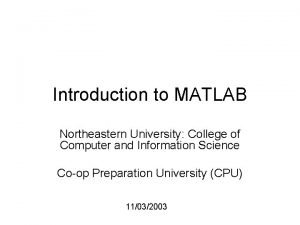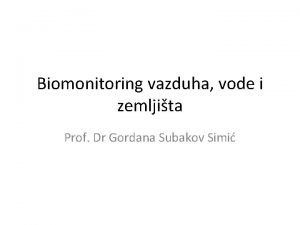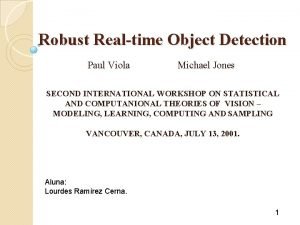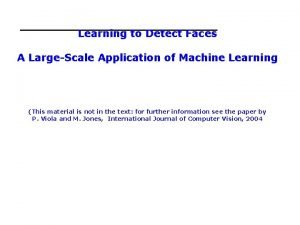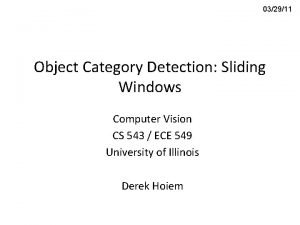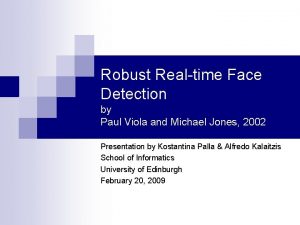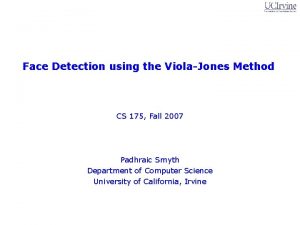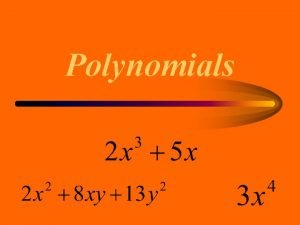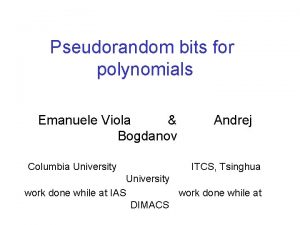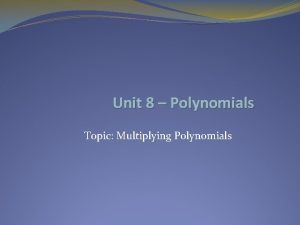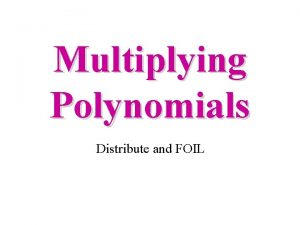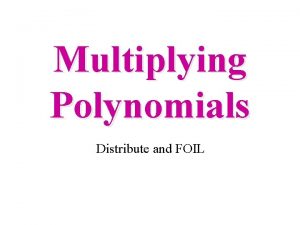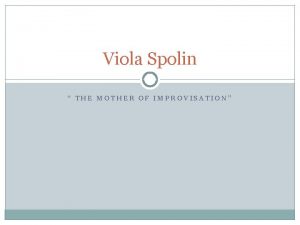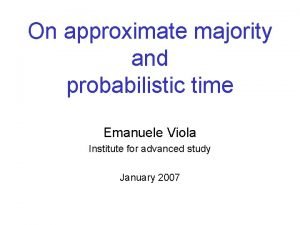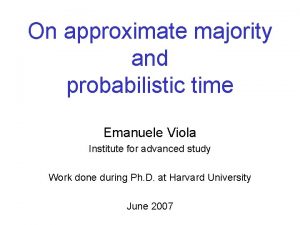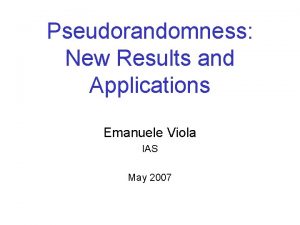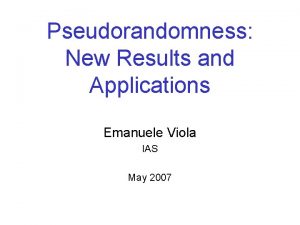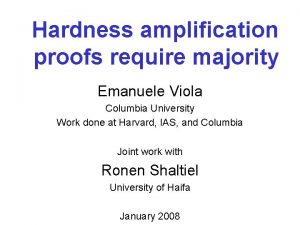Polynomials over 0 1 Emanuele Viola Northeastern University








![XOR lemma proofs require majority • XOR lemma proofs [L, GNW, I, …] are XOR lemma proofs require majority • XOR lemma proofs [L, GNW, I, …] are](https://slidetodoc.com/presentation_image_h2/93ed228e458c35f5109876843ef9681e/image-9.jpg)
![[Shaltiel V. ’ 07] + [Razborov Rudich] + [Naor Reingold] “Lose-lose” reach of standard [Shaltiel V. ’ 07] + [Razborov Rudich] + [Naor Reingold] “Lose-lose” reach of standard](https://slidetodoc.com/presentation_image_h2/93ed228e458c35f5109876843ef9681e/image-10.jpg)
![Where we are • Theorem[Shaltiel V. ’ 07]: Code-theoretic proofs of XOR lemma do Where we are • Theorem[Shaltiel V. ’ 07]: Code-theoretic proofs of XOR lemma do](https://slidetodoc.com/presentation_image_h2/93ed228e458c35f5109876843ef9681e/image-11.jpg)
![XOR lemma for constant degree • Theorem[V. Wigderson]: XOR lemma for degree O(1) • XOR lemma for constant degree • Theorem[V. Wigderson]: XOR lemma for degree O(1) •](https://slidetodoc.com/presentation_image_h2/93ed228e458c35f5109876843ef9681e/image-12.jpg)
![Gowers norm [Gowers ’ 98; Alon Kaufman Krivelevich Litsyn Ron ‘ 03] • Measure Gowers norm [Gowers ’ 98; Alon Kaufman Krivelevich Litsyn Ron ‘ 03] • Measure](https://slidetodoc.com/presentation_image_h2/93ed228e458c35f5109876843ef9681e/image-13.jpg)



![Pseudorandom generator [Blum Micali; Yao; Nisan Wigderson] Gen • Efficient • Short seed s(n) Pseudorandom generator [Blum Micali; Yao; Nisan Wigderson] Gen • Efficient • Short seed s(n)](https://slidetodoc.com/presentation_image_h2/93ed228e458c35f5109876843ef9681e/image-17.jpg)
![Previous results • Th. [Naor ‘ 90]: Fools linear, seed = O(log n/e) – Previous results • Th. [Naor ‘ 90]: Fools linear, seed = O(log n/e) –](https://slidetodoc.com/presentation_image_h2/93ed228e458c35f5109876843ef9681e/image-18.jpg)

![Recent developments after [BV] • Th. [Lovett]: The sum of 2 d generators for Recent developments after [BV] • Th. [Lovett]: The sum of 2 d generators for](https://slidetodoc.com/presentation_image_h2/93ed228e458c35f5109876843ef9681e/image-20.jpg)
![Our latest result • Theorem[V. ]: The sum of d generators for degree 1 Our latest result • Theorem[V. ]: The sum of d generators for degree 1](https://slidetodoc.com/presentation_image_h2/93ed228e458c35f5109876843ef9681e/image-21.jpg)



![Recent applications • Fool width-2 read-d branching programs [Bogdanov Dvir Verbin Yehudayoff] • Polynomial Recent applications • Fool width-2 read-d branching programs [Bogdanov Dvir Verbin Yehudayoff] • Polynomial](https://slidetodoc.com/presentation_image_h2/93ed228e458c35f5109876843ef9681e/image-25.jpg)

![Open problems [Nisan-Wigderson] ``strong’’ Correlation bound [Observation] Correlation bound Pseudorandom generator ? ? • Open problems [Nisan-Wigderson] ``strong’’ Correlation bound [Observation] Correlation bound Pseudorandom generator ? ? •](https://slidetodoc.com/presentation_image_h2/93ed228e458c35f5109876843ef9681e/image-27.jpg)
- Slides: 27

Polynomials over {0, 1} Emanuele Viola Northeastern University work done at Columbia, IAS, and Harvard October 2008

Polynomials • Polynomials: degree d, n variables over F 2 = {0, 1} E. g. , p = x 1 + x 5 + x 7 p = x 1 x 2 + x 3 degree d = 1 degree d = 2 • Computational model: p : {0, 1}n ® {0, 1} Sum (+) = XOR, Product ( ) = AND x 2 = x over F 2 Þ Multilinear • Complexity = degree

Motivation • Coding theory Hadamard, Reed-Muller codes based on polynomials • Circuit lower bounds [Razborov ’ 87; Smolensky ’ 87] Lower bound on polynomials Þ circuit lower bound • Pseudorandomness [Naor & Naor ‘ 90] Useful for algorithms, PCP, expanders, learning…

Outline • Overview • Correlation bounds • Pseudorandom generators

Lower bound • Question: Which functions cannot be computed by low-degree polynomials? • Answer: x 1 x 2 xd requires degree d Majority(x 1, …, xn) : = 1 Û S xi > n/2 requires degree n/2

Correlation bound • Question: Which functions do not correlate with low-degree polynomials? • Cor(f, degree d) : = maxdegree-d p Bias(f+p) Î [0, 1] Bias(f+p) : = | Pr. U Î {0, 1}n [f(U)=p(U)] – Pr. U [f(U)≠p(U)] | E. g. Cor(deg. d, deg. d) = 1; Cor(random f, deg. d) » 0 • Want: correlation small, degree large. • Barrier: $ explicit n-bit f : Cor(f, degree log 2 n) £ 1/n ?

A sample of correlation bounds • [Babai, Nisan and Szegedy ’ 92, Bourgain ’ 05, Green Roy Straubing ’ 05]: Explicit f: Cor(f, degree 0. 1 log n) £ exp(-n) • [Razborov ’ 87]: Explicit f : Cor(f, degree n 1/3) £ 1/ n • Hardness amplification question: Can amplify Razborov’s bound to break the “Cor(f, degree log n) £ 1/n” barrier?

Yao’s XOR lemma • Generic way to boost correlation bound M = computational model (e. g. M = degree log n) • fÅk(x 1, …, xk) : = f(x 1) Å Å f(xk) Hope: Cor(fÅk, M) £ Cor(f, M)W(k) • Theorem [Yao, Levin, Goldreich Nisan Wigderson, Impagliazzo, …] XOR lemma for M = circuits • Question: [Razborov] bound for f + XOR lemma Þ Cor( f(x 1) Å Å f(xk), degree log n ) << 1/n ?
![XOR lemma proofs require majority XOR lemma proofs L GNW I are XOR lemma proofs require majority • XOR lemma proofs [L, GNW, I, …] are](https://slidetodoc.com/presentation_image_h2/93ed228e458c35f5109876843ef9681e/image-9.jpg)
XOR lemma proofs require majority • XOR lemma proofs [L, GNW, I, …] are code-theoretic • Theorem [Shaltiel V. ’ 07]: Code-theoretic proofs of XOR lemma require model to compute majority • Since polynomials cannot compute majority, no code-theoretic proof of XOR lemma for polynomials
![Shaltiel V 07 Razborov Rudich Naor Reingold Loselose reach of standard [Shaltiel V. ’ 07] + [Razborov Rudich] + [Naor Reingold] “Lose-lose” reach of standard](https://slidetodoc.com/presentation_image_h2/93ed228e458c35f5109876843ef9681e/image-10.jpg)
[Shaltiel V. ’ 07] + [Razborov Rudich] + [Naor Reingold] “Lose-lose” reach of standard techniques: Majority Cannot prove XOR lemma [Shaltiel V. ] Power of model Cannot prove Correlation bounds [RR] + [NR] ``natural proofs barrier’’ “You can only amplify the hardness you don’t know”
![Where we are TheoremShaltiel V 07 Codetheoretic proofs of XOR lemma do Where we are • Theorem[Shaltiel V. ’ 07]: Code-theoretic proofs of XOR lemma do](https://slidetodoc.com/presentation_image_h2/93ed228e458c35f5109876843ef9681e/image-11.jpg)
Where we are • Theorem[Shaltiel V. ’ 07]: Code-theoretic proofs of XOR lemma do not work for polynomials • Open: XOR lemma for degree log n • Note: XOR lemma trivially true for degree 0, 1 • Next[V. Wigderson]: XOR lemma for any constant degree Proof not code-theoretic
![XOR lemma for constant degree TheoremV Wigderson XOR lemma for degree O1 XOR lemma for constant degree • Theorem[V. Wigderson]: XOR lemma for degree O(1) •](https://slidetodoc.com/presentation_image_h2/93ed228e458c35f5109876843ef9681e/image-12.jpg)
XOR lemma for constant degree • Theorem[V. Wigderson]: XOR lemma for degree O(1) • Technique: Use norm N(f) » [0, 1] : (I) Cor(f, degree d) » N(f) (II) N(fÅk) = N(f)k • Proof of the XOR lemma: Cor(fÅk, degree d) » N(fÅk) = N(f)k » Cor(f, degree d)k Q. e. d.
![Gowers norm Gowers 98 Alon Kaufman Krivelevich Litsyn Ron 03 Measure Gowers norm [Gowers ’ 98; Alon Kaufman Krivelevich Litsyn Ron ‘ 03] • Measure](https://slidetodoc.com/presentation_image_h2/93ed228e458c35f5109876843ef9681e/image-13.jpg)
Gowers norm [Gowers ’ 98; Alon Kaufman Krivelevich Litsyn Ron ‘ 03] • Measure correlation with degree-d polynomials: check if random d-th derivative is biased • Derivative in direction yÎ {0, 1}n : Dy p(x) : = p(x+y) - p(x) – E. g. Dy 1 y 2 y 3(x 1 x 2 + x 3) = y 1 x 2 + x 1 y 2 + y 3 • Norm Nd(p) : = EY 1…Yd Î{0, 1}n Bias. U[DY 1…Yd p(U)] Î [0, 1] (Bias [Z] : = | Pr[ Z = 0 ] - Pr[ Z = 1] | ) Nd(p) = 1 Û p has degree d • From combinatorics [Gowers; Green Tao], to PCP [Samorodnitsky Trevisan], to correlation bounds [V. Wigderson]

Properties of norm • Nd(p) : = EY 1…Yd Î{0, 1}n Bias. U[DY 1…Yd p(U)] (I) Nd(f) » Cor(f, degree d) : Lemma[Gowers, Green Tao]: d 1/2 Cor(f, degree d) £ Nd(f) Lemma[Alon Kaufman Krivelevich Litsyn Ron]: (Gowers inverse conjecture, N » 1 case) Cor(f, degree d) £ 1/2 Þ Nd(f) £ 1 -2 -d (II) N(fÅk) = N(f)k Follows from definition

Proof of XOR lemma (I) Nd+1(f) » Cor(f, degree d) : d 1/2 Lemma[G, GT]: Cor(f, degree d) £ Nd(f) Lemma[AKKLR]: Cor(f, degree d) £ 1/2 Þ Nd(f) £ 1 -2 -d (II) N(fÅk) = N(f)k • Theorem[V. Wigderson]: Cor(f, deg. d) £ 1/2 Þ Cor(fÅk, deg. d) £ exp(-k/4 d) • Proof: d d d Åk Åk 1/2 k/2 -d k/2 Cor(f , deg. d) £ Nd(f ) = Nd(f) £ (1 -2 ) Q. e. d. • More[VW]: Best known bound for degree 0. 5 log n, …

Outline • Overview • Correlation bounds • Pseudorandom generators
![Pseudorandom generator Blum Micali Yao Nisan Wigderson Gen Efficient Short seed sn Pseudorandom generator [Blum Micali; Yao; Nisan Wigderson] Gen • Efficient • Short seed s(n)](https://slidetodoc.com/presentation_image_h2/93ed228e458c35f5109876843ef9681e/image-17.jpg)
Pseudorandom generator [Blum Micali; Yao; Nisan Wigderson] Gen • Efficient • Short seed s(n) << n • Output “fools” degree-d polynomial p | Bias. XÎ{0, 1}s [p(Gen(X))] - Bias. UÎ{0, 1}n [p(U)] | £ e
![Previous results Th Naor 90 Fools linear seed Olog ne Previous results • Th. [Naor ‘ 90]: Fools linear, seed = O(log n/e) –](https://slidetodoc.com/presentation_image_h2/93ed228e458c35f5109876843ef9681e/image-18.jpg)
Previous results • Th. [Naor ‘ 90]: Fools linear, seed = O(log n/e) – Applications: derandomization, PCP, expanders, learning… • Th. [Luby Velickovic Wigderson ‘ 93]: Fools constant degree, seed = exp( log n/e) – [V. ‘ 05] gives modular proof of more general result • Th. [Bogdanov ‘ 05]: Any degree, but over large fields • Over small fields such as {0, 1}: no progress since 1993, even for degree d=2

Our results • To fool degree d: Let L Î {0, 1}n fool linear polynomials [NN] bit-wise XOR d independent copies of L: Generator : = L 1 + … + Ld • Theorem[Bogdanov V. ]: (I) Unconditionally: Fool degree d = 2, 3 (II) Under “d vs. d-1 inverse conjecture”: Any degree • Optimal seed s = O(log n) for fixed degree and error
![Recent developments after BV Th Lovett The sum of 2 d generators for Recent developments after [BV] • Th. [Lovett]: The sum of 2 d generators for](https://slidetodoc.com/presentation_image_h2/93ed228e458c35f5109876843ef9681e/image-20.jpg)
Recent developments after [BV] • Th. [Lovett]: The sum of 2 d generators for degree 1 fools degree d, unconditionally. – Recall [BV] sums d copies • Progress on “d vs. d-1 inverse conjecture”: • Th. [Green Tao]: True when |F| > d Proof uses techniques from [BV] works when |F| > d or d = 2, 3 • Th. [Green Tao], [Lovett Meshulam Samorodnitsky]: False when F = {0, 1}, d = 4
![Our latest result TheoremV The sum of d generators for degree 1 Our latest result • Theorem[V. ]: The sum of d generators for degree 1](https://slidetodoc.com/presentation_image_h2/93ed228e458c35f5109876843ef9681e/image-21.jpg)
Our latest result • Theorem[V. ]: The sum of d generators for degree 1 fools polynomials of degree d. For every d and over any field. (Despite the inverse conjecture being false) • Improves on both [Bogdanov V. ] and [Lovett] • Also simpler proof

Proof idea • Recall: want to show the sum of d generators for degree 1 fools degree-d polynomial p • Induction: Fool degree d Þ fool degree-(d+1) p Inductive step: Case-analysis based on Bias(p) : = | Pr. UÎ{0, 1}n [p(U)=1] – Pr. U [p(U)=0] | Cases: • Bias(p) negligible Þ Fool p using extra copy of generator for degree 1 • Bias(p) noticeable Þ p close to degree-d polynomial Þ fool p by induction

Case Bias(p) negligible • Hypothesis: L 1, …, Ld, L over {0, 1}n fool degree 1 W : = L 1 + + Ld fools degree d • Goal: For degree-(d+1) p: Bias (p(W+L)) » Bias (p(U)) • Lemma[V]: Bias (p(W + L)) £ Bias (p(U)) » 0 • Proof: Bias. W, L [p(W + L)]2 = EW [ Bias. L (p(W+L)) ]2 £ EW [ Bias. L, L’ (p(W+L) + p(W+L’)) ] degree d in W » EU [ Bias. L, L’ (p(U+L) + p(U+L’)) ] » Bias. U(p)2 Q. e. d.

Case Bias(p) noticeable • Bias(p) noticeable; p has degree d+1 • p noticeably correlates with constant (51 %) Self-correction [Bogdanov V. ] This result used in [Green Tao] • p highly correlates with (function of) degree-d polynomials • Apply induction (99 %)
![Recent applications Fool width2 readd branching programs Bogdanov Dvir Verbin Yehudayoff Polynomial Recent applications • Fool width-2 read-d branching programs [Bogdanov Dvir Verbin Yehudayoff] • Polynomial](https://slidetodoc.com/presentation_image_h2/93ed228e458c35f5109876843ef9681e/image-25.jpg)
Recent applications • Fool width-2 read-d branching programs [Bogdanov Dvir Verbin Yehudayoff] • Polynomial reconstruction problem [Gopalan Khot Saket] • Degree bounds for annihilating polynomials Given p 1, …, pt, what is min. deg. of q : q(p 1, …, pt) = 0? formal [Dvir Gabizon Wigderson, Kayal] informal [Mossel Shpilka Trevisan, Shpilka] + [BV, L, V]

What we have seen • Computational model: degree-d polynomials over F 2 Arises in codes, lower bounds, pseudorandomness • Correlation bounds Standard XOR lemma does not work [Shaltiel V. ] XOR lemma for constant degree [V. Wigderson] • Pseudorandom generators Recent developments [BV, L, GT, LMS] Sum of d generators for degree 1 fools degree d [V. ]
![Open problems NisanWigderson strong Correlation bound Observation Correlation bound Pseudorandom generator Open problems [Nisan-Wigderson] ``strong’’ Correlation bound [Observation] Correlation bound Pseudorandom generator ? ? •](https://slidetodoc.com/presentation_image_h2/93ed228e458c35f5109876843ef9681e/image-27.jpg)
Open problems [Nisan-Wigderson] ``strong’’ Correlation bound [Observation] Correlation bound Pseudorandom generator ? ? • Still open: Understand these connections
 Emanuele viola
Emanuele viola Emanuele viola
Emanuele viola Matlab northeastern university
Matlab northeastern university Northeastern university
Northeastern university Northeastern university
Northeastern university Matlab uiputfile
Matlab uiputfile Rizal sa singapore
Rizal sa singapore Konwolucyjne sieci neuronowe wikipedia
Konwolucyjne sieci neuronowe wikipedia Viola mäemurd
Viola mäemurd Violina viola violoncelo kontrabas
Violina viola violoncelo kontrabas Ivan viola
Ivan viola Emma patronka
Emma patronka Alohtono značenje
Alohtono značenje Robust real-time object detection
Robust real-time object detection Viola da braco
Viola da braco Viola jones
Viola jones Viola grasso
Viola grasso Viola jones
Viola jones Robust real-time object detection
Robust real-time object detection Raggio viola
Raggio viola Reliktumfaj
Reliktumfaj Robust real-time face detection
Robust real-time face detection Font detector
Font detector Viola jones
Viola jones Viola systems
Viola systems Tipologi mazhab italia dan mazhab perancis
Tipologi mazhab italia dan mazhab perancis Arca dei suoni
Arca dei suoni Prima relazione fondamentale della goniometria
Prima relazione fondamentale della goniometria
